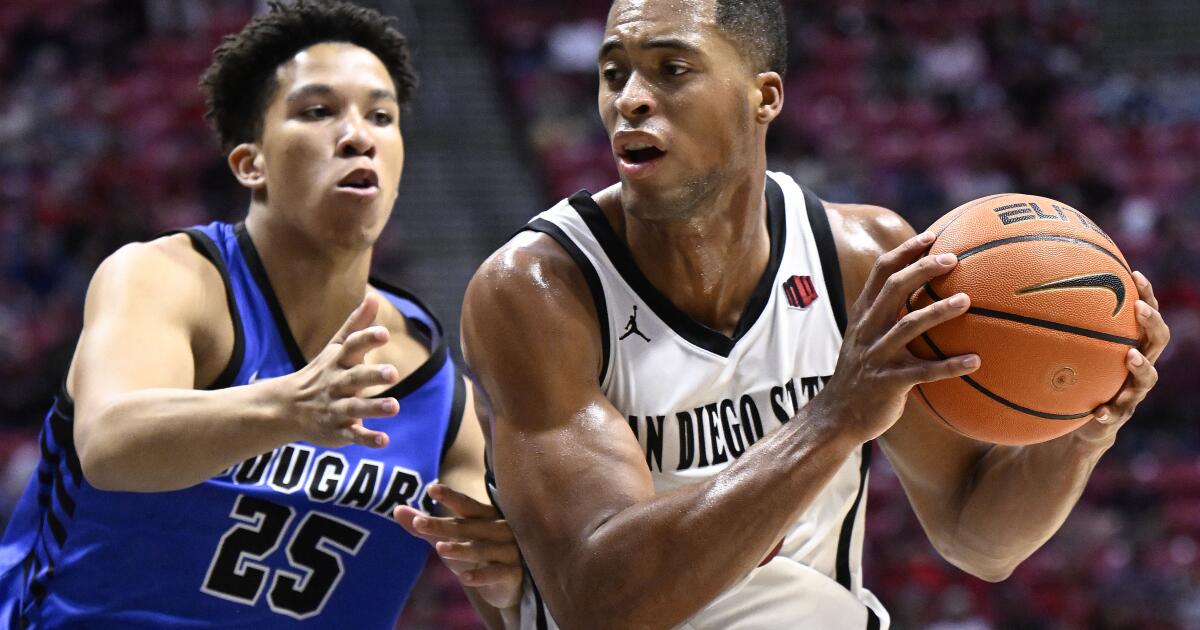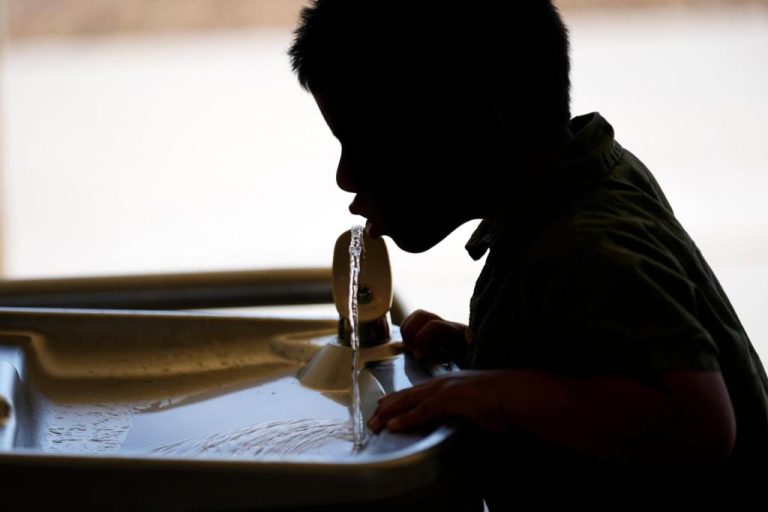
Three thoughts on No. 17 San Diego State’s 81-50 exhibition victory against Cal State San Marcos on Monday night at Viejas Arena, with the Nov. 6 season opener looming:
1. The press
SDSU won the opening tip, got into their halfcourt offense and fed the ball to Elijah Saunders. Who was whistled for traveling.
Cal State San Marcos inbounded from the baseline … and looked up to see the Aztecs aligned in a full-court press. It was a common sight all night.
It could be a common sight all season.
Without the backline presence of two-time Mountain West Defensive Player of the Year Nathan Mensah, who allowed them to play the percentages of half-court defense with his ability to protect the rim, the Aztecs could opt to extend the full 94 feet and take advantage of a smaller, quicker lineup.
It worked against the Division II Cougars, forcing a good chunk of their 15 turnovers that led to 21 Aztecs points — more than a quarter of their total output. There were a couple backcourt steals that led to easy points. There were a few intercepted passes as the Cougars tried to cross midcourt. There was a 10-second violation.
But mostly what it did was exhaust them, reinforcing the basketball maxim that the dividends of a press aren’t paid until the second half.
First-half shooting: 40 percent.
Second-half shooting: 20.8 percent.
The Cougars attempted 13 3-pointers in each half. They made five in the first and two in the second.
“It’s hard to shoot the ball on tired legs,” coach Brian Dutcher said. “Maybe they were getting some of the same shots, but they weren’t going in because they were probably fatigued. We wore them down as the game went on. We do that to a lot of people.”
So the press is here to stay?
Maybe, maybe not.
The other ingredient for an effective press is depth and, unlike last season, the Aztecs may or may not have it. The five scholarship players who came off the bench Monday played a combined total of 165 minutes last season for SDSU.
It doesn’t mean they aren’t capable. It means they’re not proven at this level.
“You have to have depth to press all game,” Dutcher said. “Depth is all based on who’s productive. We’ll play some guys, and if our production drops we won’t play as many guys. If our production stays high, we’ll play a deep bench again. They’ll determine that, not me.”
2. One-man wrecking crew
It is two letters in the expanded box score: FD, or fouls drawn.
Jaedon LeDee is really, really good at it.
Monday night, the 6-9, 240-pound physical specimen drew 11 fouls in 25 minutes against the overmatched Cougars, seven coming in the opening eight minutes and nine in the first half. He fouled out starting center Charlie Henderson in just 16½ minutes. The next big off the bench got four fouls.
Perspective: LeDee’s effort translates to 17.6 fouls drawn over 40 minutes. The national leader last season, Vanderbilt 7-footer Liam Robbins, averaged 8.6 per 40 minutes.
LeDee ranked in the top 100 last season. With extended minutes and an expanded role, expect him to be among the national leaders in the often overlooked statistical category.
“That’s going to be a standard for him,” Dutcher said. “He’s a physical presence in there. I have to make sure he gets the fouls he deserves. He draws a foul almost every time he’s in there, and eventually the refs don’t want to call them all.”
LeDee shrugged when asked about it.
“I like to make my presence known and play physical,” he said. “That’s what we want to carry over from last year to this year. … Using our physicality, that’s our staple here.”
3. NIT-wits
The start of the college basketball season is less than a week away, but a decision about its end was made last week, unfortunately, with little fanfare.
The National Invitational Tournament, an event steeped in history that now plays second fiddle to the NCAA Tournament, changed its entry format. In the past, the NIT gave automatic berths to regular-season champions of Division I’s 33 conferences who didn’t win their conference tournament (and thus go to the NCAA Tournament). That’s out.
Instead, the event will give spots to the two best remaining teams in each of basketball’s six “power” conferences — no matter their record or metrics. Last season, that would have included 16-19 Ohio State and 16-17 Florida, plus three teams that finished with .500 records and five teams with NET metrics above 70.
The power-conference entrants also will be seeded teams with guaranteed home games in the opening round, and likely longer. The rest of the 32-team bracket will be backfilled from the other 27 conferences, and only four get home games.
It is a concerted effort to get more “name” schools deeper into the tournament, and by extension draw larger TV viewership for a struggling entity that moved its semifinals and championship game last season from its traditional home of New York’s Madison Square Garden to a bare-bones venue at The Orleans, an off-Strip Las Vegas casino.
Fox Sports had threatened to host its own 16-team postseason event with power conference leftovers, which forced the NIT’s hand for fear it would exclusively become a receptacle for the Big Souths and Big Wests of the college basketball world. More finals like last season’s North Texas-UAB game, as exciting as that game was, aren’t good for business.
SDSU doesn’t aspire to the NIT. It has played in the tournament only once in the previous 14 seasons, advancing to the 2016 semis at MSG in what ultimately amounted to a fantastic experience for players bitterly disappointed at being snubbed by the NCAA Tournament selection committee.
Mountain West teams will still have access to the NIT based on their metrics that have steadily climbed in recent years. But advancing will, in many cases, require winning on the road with cross-country travel and short rest.
Good luck with that.






